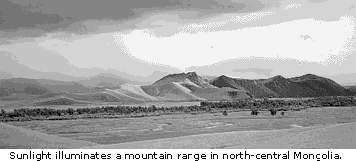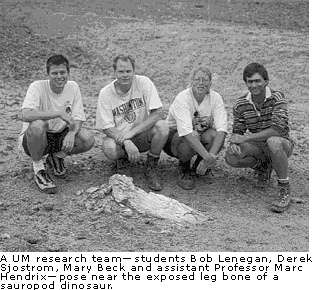SPRING 1998
Volume 15, Number 3

Uncovering the Geology
of Mongolia
by Cary Shimek
Photos by Marc Hendrix
Mongolia is known as the homeland of Genghis Khan, the thirteenth-century ruler whose armies swept out of their harsh land to forge the greatest land empire the world has ever known. It is a premier place to hunt dinosaur remains - Western explorers found nearly complete dinosaur eggs and fossils in the Gobi Desert. It is also a geologist’s candy store, according to Marc Hendrix, an assistant professor of geology at The University of Montana, because it contains some of the world’s most extensive mountain systems.
premier place to hunt dinosaur remains - Western explorers found nearly complete dinosaur eggs and fossils in the Gobi Desert. It is also a geologist’s candy store, according to Marc Hendrix, an assistant professor of geology at The University of Montana, because it contains some of the world’s most extensive mountain systems.
The country is roughly one-quarter the size of the United States. About one million of the nation’s 2.5 million inhabitants live in the capital of Ulan Batar, while many of the rest roam the countryside in a nomadic lifestyle that hasn’t changed much since the days of Genghis. They are expert horsemen, they drink cumis - fermented mare’s milk with an alcoholic kick - and they live in dome-shaped felt huts called gers. In the rainier areas, herders raise yaks and sheep; in the drier regions, camels.
The stark landscape was the crucible that forged Mongolians into the hardy people they have become. There are steppe-country grasslands to the east, the rugged Hangay-Hentai Plateau to the north, high mountains of sagebrush and saline lakes to the west, and, to the south, red rocks scattered across the flat Gobi Desert. The dust hanging over the multicolored rocks of the Gobi create some of the most fantastic sunsets on earth.
Unexplored Country
Locked behind the Iron Curtain, Mongolia was a black hole on the maps of western geologists until 1990, when the country shrugged off communism and turned to democracy. Hendrix, who joined UM’s faculty in 1994, was one of the first American geologists to visit a more open Mongolia. Since 1991, Hendrix has journeyed to Mongolia six times.
“It’s been truly exciting to unravel the earth history of a place that few western geologists have ever seen,” he said. “It’s been an epic experience.”
Hendrix, who studies the relationship between sedimentation and plate tectonics, said central Asia is an ideal place for geologists to study the development and the demise of mountain systems. He researches the rise and fall of Mongolia’s ancient mountains by examining the sands and gravels that result from erosion. These sediments are preserved in low-lying areas called basins. Over time these basins receive sediment from eroded mountain ranges, acting as a sort of geologic tape recorder. Basin sediment can tell Hendrix the approximate location, composition and orientation of the mountains, even the direction rivers flowed from the eroding landforms.
Hendrix said his Mongolian research has three goals: to collect base-line data about the geology; to learn if the mountain-building events that occurred in China during the Mesozoic Era - 98 million to 245 million years ago - also occurred in Mongolia; and to explore for signs of petr oleum.
oleum.
Hendrix has learned that 160 million years ago much of southern Mongolia was squeezed together, creating a large mountain range. These mountains became so immense that they began to collapse under their own weight - like a too-tall soufflé. During this period, portions of southern Mongolia collapsed to such a large degree that the upper half of the earth’s crust slid completely off the lower half. This left the lower crust exposed on the earth’s surface for Hendrix’s teams to study.
The Gobi Desert’s exposed geology is especially interesting to Hendrix, and his research groups have spent a lot of time working there. “The Gobi is full of naked rock,” he said. “Those rocks preserve the history of mountains long since eroded, climates long since changed, and creatures long since extinct.”
In the Gobi, Hendrix’s team also has discovered a petrified forest that was blown down by a large volcanic eruption and a Soviet oil field that was abandoned in the late 1960s after a refinery fire. In western Mongolia, the team found the remains of Mongolia’s most ancient dinosaur - the right foot of a Late Jurassic sauropod called Mamenchisaurus - the only dinosaur find so far in that part of the country.
Adventures on the Gobi
Hendrix loves the travel associated with geology. But along the way, his expeditions have had their share of adventures. 
On his first trip, one of the trucks rolled while he was riding in its canvas-covered bed. “Of course there were no seat belts.” he said. “It was complete chaos.” The truck came to rest upside down, and Hendrix was knocked unconscious for a few minutes. “When the truck stopped rolling, I was lying on the desert sand with my legs still stuck in the truck,” he said. “I panicked a little when I couldn’t move my legs, but then I realized people were lying on them.” His team survived with concussions, bumps and bruises.
In 1992, Hendrix took a 1,500-mile trek in Russian-made troop transports through the western and southern portions of Mongolia with two Americans and five Mongolians. Since there are only a few hundred kilometers of paved road in the country, most of the trip was on unmaintained dirt tracks. Many rivers had no bridges, so they had to be forded. It took them a week to cover 500 miles.
As the group traveled across the Asian wilderness, they would often stop at gers to sample Mongolian hospitality. “The people in Mongolia are exceedingly good-natured,” Hendrix said. “They share a love of life and tradition that seems rare in most Western societies.”
This past year, the team wandered out beyond the last ger in a remote corner of southwestern Mongolia. The area was extremely dry and had no local water supply. Heat soon claimed two of their four trucks, and the field party had to ration the last few gallons of water. Hendrix and two Mongolians set out to scout for water, checking any patches of greenery for signs of water. The team eventually found an old well used for watering horses.
His team also has traveled to within a mile of the Chinese border, into a no man’s land that required an escort by Mongolian soldiers. “The Mongolian army appears to be out of money,” Hendrix said. “The two soldiers with us weren’t given clips for their guns until just before we were about to depart for the field. At one point we passed an army outpost and were told the two guards there had to walk the fifty miles from the army base to the outpost.”
In Genghis’ Footsteps
In recent years, UM graduates and undergraduates have trekked with Hendrix to some of the most remote corners of central Asia. Mary Beck, who is doing her master’s thesis on the sedimentation of a small mountain in the southern Gobi, fell in love with Asia during her visit to Mongolia, and next year she will do research in the Himalayas. “Mongolia really solidified for me what I wanted to do,” she said. “You get to know the land on different terms than when you just drive through the area. It was a life-transforming experience.”
Hendrix enjoys giving his students a Mongolian experience. “It is particularly interesting traveling in third world countries,” he said, “because you are confronted by so many things you didn’t even know existed.” M
Cary Shimek is a news editor at University Relations.